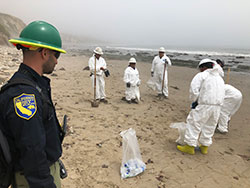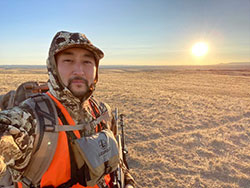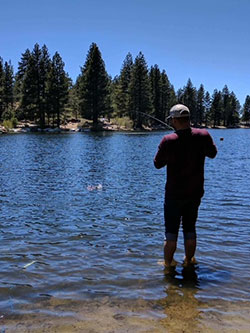Roy Kim is an environmental scientist for CDFW’s Office of Spill Prevention and Response (OSPR), for which he responds to petroleum-related incidents throughout Central California. As part of OSPR’s Central Field Response Team, his role is to assess environmental impacts caused by oil spills in collaboration with wildlife officers and prevention specialists who investigate causes and potential violations stemming from such incidents. The nature of his work is highly diverse; on any given day, he might be on the scene of a tanker truck accident, a sunken boat, or every so often, a large marine oil spill like the 2015 Refugio Incident that occurred in Santa Barbara County.
Environmental Scientist Roy Kim in Pacific Grove. Kim responds to oil spills throughout Central California, for CDFW’s Office of Spill Prevention and Response (OSPR).

Scientist Roy Kim oversees shoreline cleanup efforts in Goleta following an oil spill in June 2019.

Roy Kim took up hunting following his move to the Central Valley in 2015. He also became a hunter-education, where he’s able to help others learn the basics of hunting and firearm safety.

Scientist Roy Kim has been fishing with his father since he could first walk, inspiring a lifelong passion for the outdoors. He now continues to explore the best fishing spots in Central California.
Roy Kim is an environmental scientist for CDFW’s Office of Spill Prevention and Response (OSPR), for which he responds to petroleum-related incidents throughout Central California. As part of OSPR’s Central Field Response Team, his role is to assess environmental impacts caused by oil spills in collaboration with wildlife officers and prevention specialists who investigate causes and potential violations stemming from such incidents. The nature of his work is highly diverse; on any given day, he might be on the scene of a tanker truck accident, a sunken boat, or every so often, a large marine oil spill like the 2015 Refugio Incident that occurred in Santa Barbara County.
Roy joined OSPR as an environmental scientist in 2015, after spending several years as a scientific aid on CDFW’s Anadromous Assessment Program, where he conducted surveys for Chinook salmon, and the Coastal Pelagic Species Program, where he conducted surveys for marine species including mackerel, sardines and squid.
Roy is a graduate of California State University, Stanislaus, earning a bachelor of science degree in biology and ecology.
A native of Orange County, his love for nature and the outdoors was inspired by frequent fishing trips with his father.
You grew up close to the ocean. Have you always been a saltwater angler?
I started fishing with my dad at the Seal Beach Pier as soon as I could walk. We were out there all the time. I can remember, at an early age, seeing people from CDFW out on the jetties and charter boats conducting fish count surveys. That piqued my interest, and little did I know then that I would be one of those people conducting the surveys after I joined the department.
I was outside a lot as a kid. It not only led me to a career in environmental science, but it inspired my love for the outdoors. Once I was sure I wanted to pursue a career as a scientist, I knew it needed to be a position where I was out working in the field.
Oil spill response seems like a niche role for a scientist. What led you to pursue the position with OSPR?
I helped out with the Refugio spill when I was working as a scientific aid in Los Alamitos. Although the extent of my assistance was driving animals from Santa Barbara to rehabilitation centers further south, I remember being impressed with how efficiently and effectively so many people were working together on the spill. There were scientists, veterinarians, cleanup contractors and law enforcement officers wearing Tyvek, working together in a very organized manner to care for oiled wildlife and the environment. From then on, I knew I wanted to work not only in the field, but in that kind of a hands-on, collaborative way.
Now that you’ve been with OSPR for five years, what other spills have you responded to? What do your day-to-day activities include?
Right after I joined OSPR, I responded to the Istra Ace spill, which involved a large car carrier ship releasing fuel in the Port of Los Angeles. I also spent nearly three months at the scene of the Grove Incident in Ventura, where crude oil flowed down a culvert in a residential neighborhood near the coast. More recently, I led the environmental response for the Cuyama River Incident which involved a tanker truck accident that spilled several thousand gallons of crude oil into the Cuyama River in Santa Maria. I was hired to be based in Fresno soon after the Governor (Jerry Brown) signed legislation expanding OSPR’s jurisdiction to inland waters of the state. Between myself and others on the newly-formed inland field response team, we’ve also responded to dozens of reports of spills in the Kern County oil fields.
On a day-to-day basis, there are all kinds of reports I look into. It’s quite surprising how many lakes and rivers there are in Central California. I get calls regarding quite a few leaking or even sunken recreational boats, vehicles that overturn and spill fuel, and of course spills and potential spills due to oil and gas infrastructure.
Speaking of the recent incident, as you know that was OSPR’s first moderate-sized spill response during the pandemic. How did you embrace the challenges that came with COVID-19-related safety measures?
It was definitely an adjustment wearing masks and social distancing. With a larger response, there are usually a lot of people working to clean up the oil and the response area in this instance was fairly narrow, so it was challenging making sure everyone was six feet apart. Balancing personnel needs and social distancing, all the while attempting to conduct a timely and efficient cleanup operation was a hurdle. It also made communication a challenge. Not only were there more people working remotely, but responders in the field were in an area with poor cell phone service. All in all, we made the adjustments needed and the cleanup operations were a success.
You are one of only a few CDFW employees licensed by the Federal Aviation Administration to fly drones. How has drone usage helped in your response work?
It’s made it quicker and more efficient in some cases to collect data. We are able to get detailed photos and videos from sites where safety becomes a concern for responders. Historically, on-the-ground assessments are done by scientists walking through a site. Although it’s true that having a person on-scene trumps digital data and is almost always necessary for sampling, with the drones, we can get good footage and assess an area that would otherwise be inaccessible or unsafe. With the Cymric surface expression incident last year, we flew drones right above the actual oil expression, getting great close-up imagery. We can also transmit the data in real-time back to the Command Post. All we need is a decent internet connection.
I’ve also helped other branches of CDFW with the drone. I’m currently working with regional scientists to monitor salmon redds in central California. The drone is able to capture data such as redd counts and fish behavior that would have challenging to obtain otherwise.
As an outdoorsman, do you prefer central California to urban Southern California where you grew up?
Absolutely. Since moving to Fresno from the concrete jungle of Orange County, I think it was a natural progression that I would expand being an avid outdoorsman from fishing to hunting. There’s so much open space around here. I’ve hunted for dove, quail, pheasants, duck and deer. I’ve been fortunate to learn from people I work with who are also passionate about the outdoors. It’s also inspired me to become a CDFW Hunter Education Instructor, which has been a great experience to help people of all ages better understand gun safety and best hunting practices.
I’ve really come to love this area. There are all kinds of things to do and great places to explore when I’m not on the job.
###
CDFW Photos